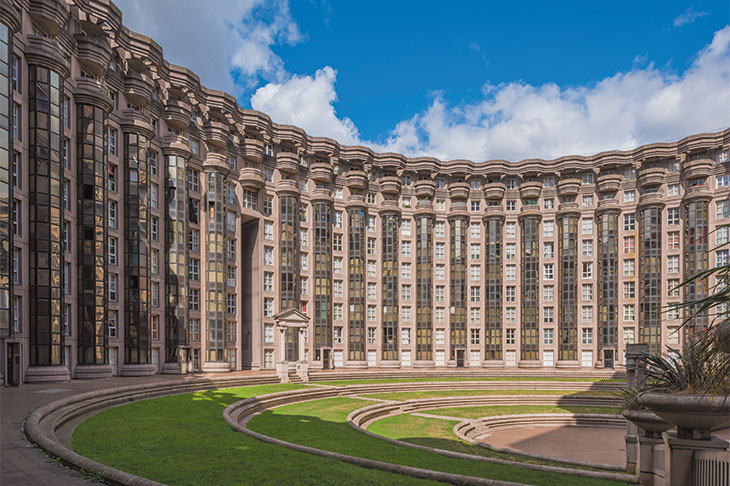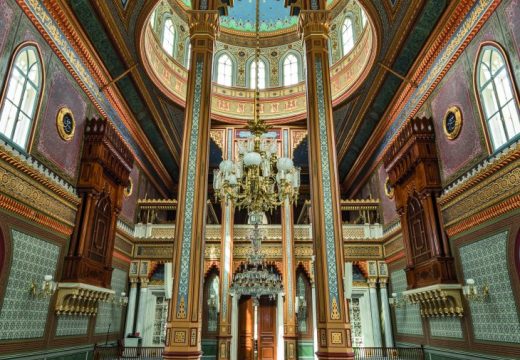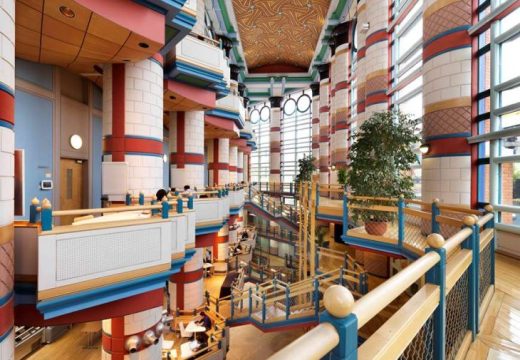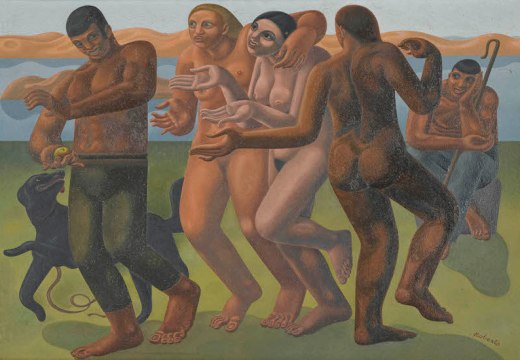The Espaces d’Abraxas is a set of social-housing blocks in Marne-la-Vallée, a new town in the Paris suburbs. It is one of several grands ensembles planned in the 1970s by the Communist-led council of Seine-Saint-Denis. Like many of these projects, the Espaces d’Abraxas is built close to an RER station and a shopping mall, but this estate is not a matter of modernist abstraction; rather it is in a warped, muscular, alarmingly imposing version of neoclassicism. Made quite visibly out of concrete panels, these multi-storey blocks are articulated into a ‘triumphal arch’ and a ‘crescent’, as if in emulation of the Champs-Élysées or Bath – an image of grandeur that would supposedly transform the lives of the proletariat of Greater Paris. The architect, Ricardo Bofill, who had been a left-wing activist against the Franco regime in his native Catalonia, regarded these devices as a way of making the ‘rituals of everyday life’ into something ‘heroic’ – a transvaluation of the French neoclassical tradition of mathematically precise visual planning.
So far, this may sound like the sort of thin neo-neoclassicism that we know from places like Poundbury in Dorset – a stage set where the most important thing is not the experience of space, but communication (‘this is a traditional building’), even if it’s made of breeze blocks. There’s a huge difference between this and how Bofill has employed his classical sources: here you cannot forget for a moment that you’re in a massive modern housing estate. The circulation areas between the arch and the crescent consist of multiple layers of intersecting concrete walkways. These are borrowed in part from the ideal prisons of Piranesi, but also evoke the futurist cities of 20th-century science fiction. The results are as disturbing as they are thrilling. Irrespective of the fact that here people freely voted for the Communist Party, the place inescapably evokes ‘totalitarianism’. Within two years of its completion in 1983, the Espaces d’Abraxas became the set for Terry Gilliam’s Brazil; more recently, it has been a set for The Hunger Games. It is, however, one of the few neoclassical structures built since the 1950s to embrace the possibilities of modernity. It is telling that it did so in response to a political demand.
One of the reasons why classicism has been so difficult to revive for those who regard themselves as modern and/or progressive is not that it wasn’t part of the 20th century, but precisely that it was, and specifically promoted by its cruellest political regimes. If at the beginning of the 1930s neoclassicism was still the dominant style of architecture in Britain, France or the United States, by 1939 modernism had almost fully replaced it. In Germany, Italy and the USSR, the reverse was the case, with modern movements strong in each country at the start of the decade, and comprehensively defeated at the end of it.
Exceptions can be found, but there’s little doubt that the Nazi regime firmly opposed the modernist architecture that had flourished in the Weimar Republic and that Stalin, after assuming absolute power in the early 1930s, moved similarly sharply against Constructivism. This is perhaps the reason why, on apprehending Charles Holden’s Senate House, a gigantic library for the University of London built of load-bearing brick faced with stone, people often still describe it, according to their political persuasion, as ‘Fascist’ or ‘Stalinist’. There are hints of both here. The foyers, with their funereal uplighters, are genuinely akin to the work of Albert Speer, while the tiered profile of the tower has something in common with Stalin’s skyscrapers, such as the Moscow State University. Holden, a Quaker and pacifist, thought his building was quintessentially English. So too did George Orwell, who used it as the model for Ingsoc’s ‘Ministry of Truth’ in Nineteen Eighty-Four.
Nazi neoclassicism, while it developed to a degree the more personal styles of traditionalist architects such as Paul Bonatz and Heinrich Tessenow, was generally extraordinarily dull. In their literalism and politesse, architects such as Albert Speer and Paul Ludwig Troost are ancestors of Poundbury’s designers (it’s no accident that its planner, Léon Krier, wrote a celebratory illustrated monograph about Hitler’s architect and munitions minister). The reactionary architects of today generally work on a much smaller scale; even Poundbury, their showcase, is basically just a village. It’s when you find a contemporary neoclassicist given a larger space, as Demetri Porphyrios was for a suburban campus at the University of Swansea, that the banality of their work is most obvious. The combination of austere correctness, absence of imagination and poor-quality detailing in this campus brings to mind what the critic Mark Fisher called ‘boring dystopia’.
The much more sustained experiments in neoclassicism in Fascist Italy and Stalin’s Soviet Union can bear greater examination as architecture. Until the very end of the Fascist regime in Italy, classicism was only one of several trends at work, alongside a strong modernist movement that had the sympathies of some in the regime. But the most prestigious projects – new towns such as Sabaudia or Tresigallo, grand public buildings such as Milan Central Station or the Naples Post Office, and most of all the EUR district in Rome – were in a distinctive and eerie style of bare surfaces, endless colonnades and empty plazas, seemingly modelled on the ‘metaphysical paintings’ of Giorgio de Chirico (somewhat ironically, this discomfiting aesthetic would be revived in the 1970s by the Communist architect Aldo Rossi, by which time it was rebranded as Postmodernism). This architecture would be exported to Mussolini’s empire in Libya, Ethiopia and Eritrea, but it was in the Soviet Union under Stalin that classicism really expanded as an imperial architecture; in Russia and Ukraine, it is often called ‘Stalin’s Empire Style’.
In architectural terms, the first phase of Stalin’s ‘revolution from above’ in the early 1930s was in the international vanguard of the time – planners and architects fleeing Germany designed entire new towns in the Urals. This shifted in the competition in 1931–33 for the (unbuilt) Palace of the Soviets, where modernism was rejected in favour of a bloated emulation of an Edwardian New York skyscraper with Lenin, King Kong-style, at the top. There were several neoclassical architects already working for the Soviet state in the ’20s, but their strict, conservative Palladianism – best exemplified by Ivan Zholtovsky’s Mokhovaya House near the Kremlin – was just as unwelcome as Constructivism. Vladimir Paperny, in his book Architecture in the Age of Stalin: Culture Two (1985), investigated how architects strained to accommodate the Soviet regime’s demands for a style that was at once rooted in the Russian past and thrusting towards the Communist future. They eventually found it in heavy yet unstable ziggurats full of symbols, sculpture, ornament and rhetoric.
The supreme achievement of Stalinist architecture was the Moscow Metro, one of the most incredible building projects of the 20th century; begun in 1934, by the early ’50s it had become a continuous propaganda Gesamtkunstwerk of friezes, mosaics and murals, lining atmospherically lit caverns and grottoes – all of it buried deep enough for the network to be able to function as shelters in the event of nuclear attack. The first stations are elegant enough, spacious marble halls in the inter-war in-between style that generally gets called ‘stripped classicism’. But as the decade went on, descending into the bloodletting of the Great Purge of 1936–38, newly built stations were filled with sculpture, chandeliers, and opulent materials including porphyry and maiolica. And built just after victory in the Great Patriotic War, Moscow’s Circle Line (and St Petersburg’s Line 1) boasted more glassware, gold mosaic and stained glass than you’d find in most palaces, only here it was all for ‘the people’ – a Soviet propaganda slogan for once fulfilled.
Between 1956 and 1989 most state socialist countries opted for their own local variants of modern architecture. In the case of mass housing, only an architectural historian would be able to spot the difference between housing estates in, for example, East and West Berlin. There was one major exception to this – Romania. From the early 1970s onwards, Nicolae Ceauşescu’s regime developed into a nationalist personality cult with an architecture to match. Instead of open space and high-rises, there would be massive neoclassical boulevards and circuses; in Bucharest, these fanned out from a preposterous Palace of the People, then the largest single building in Europe. Some Romanian critics have argued that Bofill’s massive housing schemes in outer Paris were a major inspiration for this.
This was the last time anywhere in Europe went in for neoclassicism on such a city-transforming scale, but as far as Ceauşescu was concerned, he was merely taking part in the European mainstream, in a shift back to classical values that was also evident in postmodern forms of architecture that emerged in the mid 1970s. Ceauşescu’s thinking wasn’t entirely wrong – the similarity with the Espaces d’Abraxas makes that clear – but as soon as this sort of architecture gets built at a giant scale, it takes on a sinister, domineering quality. It is no accident, for instance, that one of the last postmodern buildings in London was the ziggurat Terry Farrell designed for MI6 in the early 1990s; in its profile and mass it could easily be imagined in 1930s Moscow. The return to modernist values of lightness and newness can be seen as a reaction to the lumpen authoritarianism encapsulated in this building.
The architecture of New Labour was, accordingly, a populist, rather jokey modernism. Yet, in recent years, the pendulum has swung back to mass and tradition. London’s Architecture Foundation regularly hosts events that bring together modernists and classicists, and critics such as Ellis Woodman or the late Gavin Stamp have hailed the architect Craig Hamilton as the exemplar of non-modernist design that remains individualistic and personal, distant from the pinched dullness of Poundbury or Swansea. A new stripped classicism is almost the dominant architecture today in big cities like London or Berlin. Elder statesmen such as David Chipperfield and Hans Kollhoff and younger provocateurs such as Amin Taha are closer to Charles Holden or Paul Bonatz than they are to Zaha Hadid or Richard Rogers. Some of the resulting buildings are superb, such as Chipperfield’s monumentalised ruin at the Neues Museum in Berlin, or Taha’s perverse limestone castle (a home and office) in Clerkenwell.
There’s no good reason why architects shouldn’t engage with history, especially given how much ‘modern’ architecture is derivative or parodic of the 1920s. However, classicism, with its discipline and its ‘orders’, does seem to lend itself in modern times to periods of austerity and retrenchment. The De Chirico grids of polite apartment blocks appearing everywhere in new developments on regeneration sites in London feel increasingly bleak and unforgiving – although metaphysical colonnades appear a lot less enigmatic and sinister when each one is filled with a Costa and a Joe and the Juice.
From the January 2019 issue of Apollo. Preview and subscribe here.
Unlimited access from just $16 every 3 months
Subscribe to get unlimited and exclusive access to the top art stories, interviews and exhibition reviews.














![Masterpiece [Re]discovery 2022. Photo: Ben Fisher Photography, courtesy of Masterpiece London](http://www.apollo-magazine.com/wp-content/uploads/2022/07/MPL2022_4263.jpg)
It’s time for the government of London to return to its rightful home